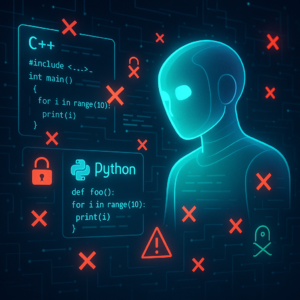Advancing LLM detection in the ALTA 2024 Shared Task: Techniques and Analysis

Unveiling AI Content: Advancing LLM Detection in the ALTA 2024 Shared Task
In today’s digital age, AI-generated content is everywhere—from the articles we read to the ads we view. This rapid influx of content generated by tools like ChatGPT has sparked a demand for reliable AI-detection methods. Enter Dima Galat’s groundbreaking study in the ALTA 2024 Shared Task, which focuses on discerning AI-generated text through innovative techniques. Join us as we delve into the key findings and their implications for the future of synthetic text detection.
A New Era in AI-Generated Content
The rise of AI-driven tools like ChatGPT-3.5 Turbo has transformed how we create and consume information. However, this evolution brings challenges, particularly in distinguishing human-generated text from AI-generated content. This capability is crucial for maintaining authenticity and trustworthiness in digital narratives.
Why Is AI Detection Important?
While AI-generated articles can enhance productivity and accessibility, they also have a darker side, including misinformation and the potential to undermine credibility. By improving detection methods, we can safeguard transparency and reliability in content creation.
Breaking Down the Research
Dima Galat’s study offers a comprehensive analysis of distinguishing AI-generated content, focusing on sentence-level evaluation within hybrid articles. Let’s explore the key aspects and findings of this research:
Understanding Probability Patterns
One of the study’s pivotal discoveries is the identification of distinct, repetitive probability patterns when ChatGPT-3.5 Turbo generates content. These patterns emerge from specific statistical models that AI systems use to anticipate and construct sentences.
-
Probability Patterns Unveiled: ChatGPT-3.5 Turbo tends to rely on predictable patterns, a byproduct of its algorithmic nature. This predictability allows trained detection methods to discern AI-generated text from human-crafted content reliably.
-
Implications for Detection: By honing in on these probability markers, we can develop more sophisticated algorithms capable of identifying AI text with high accuracy.
Resilience to Minor Textual Modifications
A common assumption is that tweaking AI-generated text (e.g., rewording or changing sentence structure) can evade detection methods. Galat’s research challenges this notion.
-
Minimal Impact of Rewording: The study’s empirical tests reveal that minor modifications to text have little effect on detection accuracy. This resilience underscores the robustness of current detection algorithms against superficial changes.
-
The Path Forward: These findings encourage developers to continue refining detection methods, ensuring that evasion tactics remain ineffective.
Practical Implications for AI Detection
The insights from this study pave the way for more reliable and practical AI detection solutions, impacting various sectors and digital platforms.
Enhancing Content Authenticity
For industries reliant on content authenticity—such as journalism, academia, and digital marketing—accurate AI text detection is a game-changer. These advancements allow for maintaining credibility and ensuring that human-generated content is distinguished from AI counterparts.
-
Journalistic Integrity: News organizations can adopt these detection methods to verify the authenticity of articles and reports, upholding journalistic standards in a digital-first era.
-
Academic Work: In academic spheres, AI detection tools can safeguard against plagiarism and ensure the integrity of scholarly work.
Combating Misinformation
The battle against misinformation often hinges on identifying its sources. With the rapid development of AI text detectors, platforms can swiftly recognize AI-generated misinformation and take action.
- Platform Accountability: Social media and content-sharing platforms can integrate these detection tools to flag and mitigate AI-generated fake news or misleading content.
Future Directions in AI Text Detection
As AI continues to advance, the methods for detecting AI-generated text must also evolve. Galat’s study sets the stage for future research, highlighting the need for continuously refining detection techniques to stay ahead of AI developments.
-
Longitudinal Analysis: Ongoing research on AI detection is crucial, as AI models become more sophisticated over time. By understanding how probability patterns change, our detection capabilities can adapt accordingly.
-
Cross-Domain Applications: Expanding detection methods to cover diverse content areas, from technical articles to creative writing, will enhance their robust applicability across different domains.
Key Takeaways
Galat’s research in the ALTA 2024 Shared Task presents a forward-looking perspective on AI detection, offering essential insights into the nuances of identifying AI-generated text. With potential for wide-ranging applications across industries, these methodologies promise to bolster content authenticity and combat misinformation in the digital world.
- Distinct Probability Patterns: ChatGPT-3.5 Turbo exhibits unique, repetitive patterns enabling reliable AI text detection.
- Minimal Impact of Textual Modifications: Real-world tests reveal that minor rewrites have negligible effect on detection accuracy.
- Practical Applications: The techniques enhance content authenticity and offer tools for combating misinformation.
- Future Research Directions: Continued evolution of detection methods is vital to outpace advances in AI models.
In a rapidly changing digital landscape, Galat’s study is a beacon guiding us toward a future where AI and human-generated content coexist transparently and authentically. As we welcome advancements in technology, let us also embrace the responsibility of ensuring that truth and accuracy remain foundational elements of our digital universe.




